Consumer Buying Behavior Towards Wine in Selangor: A Research Proposal
VerifiedAdded on 2022/09/05
|41
|11160
|18
Report
AI Summary
This research proposal investigates consumer behavior towards wine purchases in Selangor, Malaysia. The study aims to explore the influence of various factors, including country of origin, brand image, price, and taste, on consumer buying decisions. The research will address specific objectives and questions, proposing a comprehensive literature review, a conceptual framework, and a detailed research methodology. The methodology will involve a quantitative approach to analyze data and address the research questions. The study will explore the gaps in existing literature, and the findings will contribute to a better understanding of consumer behavior in the wine market of Selangor.
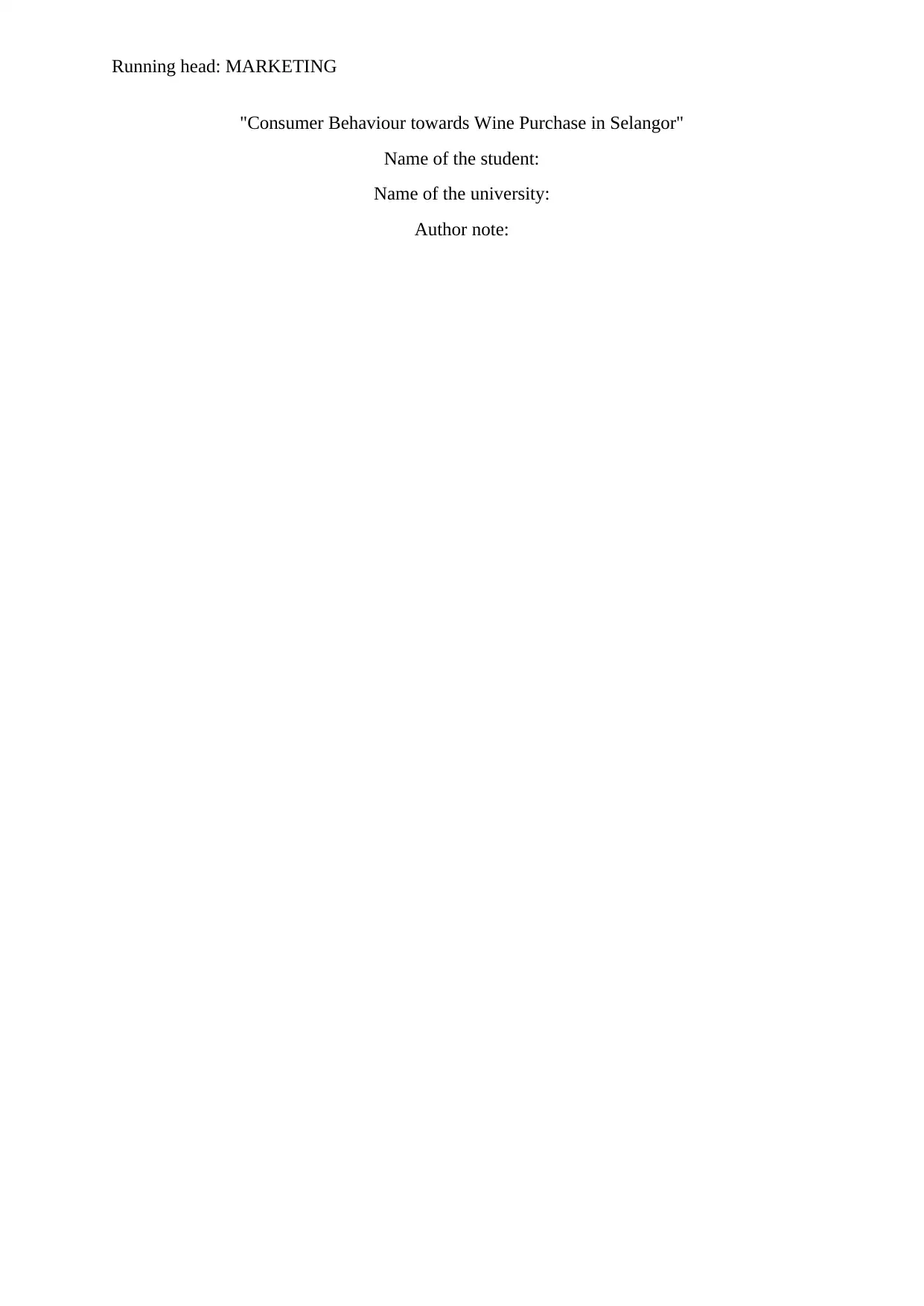
Running head: MARKETING
"Consumer Behaviour towards Wine Purchase in Selangor"
Name of the student:
Name of the university:
Author note:
"Consumer Behaviour towards Wine Purchase in Selangor"
Name of the student:
Name of the university:
Author note:
Paraphrase This Document
Need a fresh take? Get an instant paraphrase of this document with our AI Paraphraser
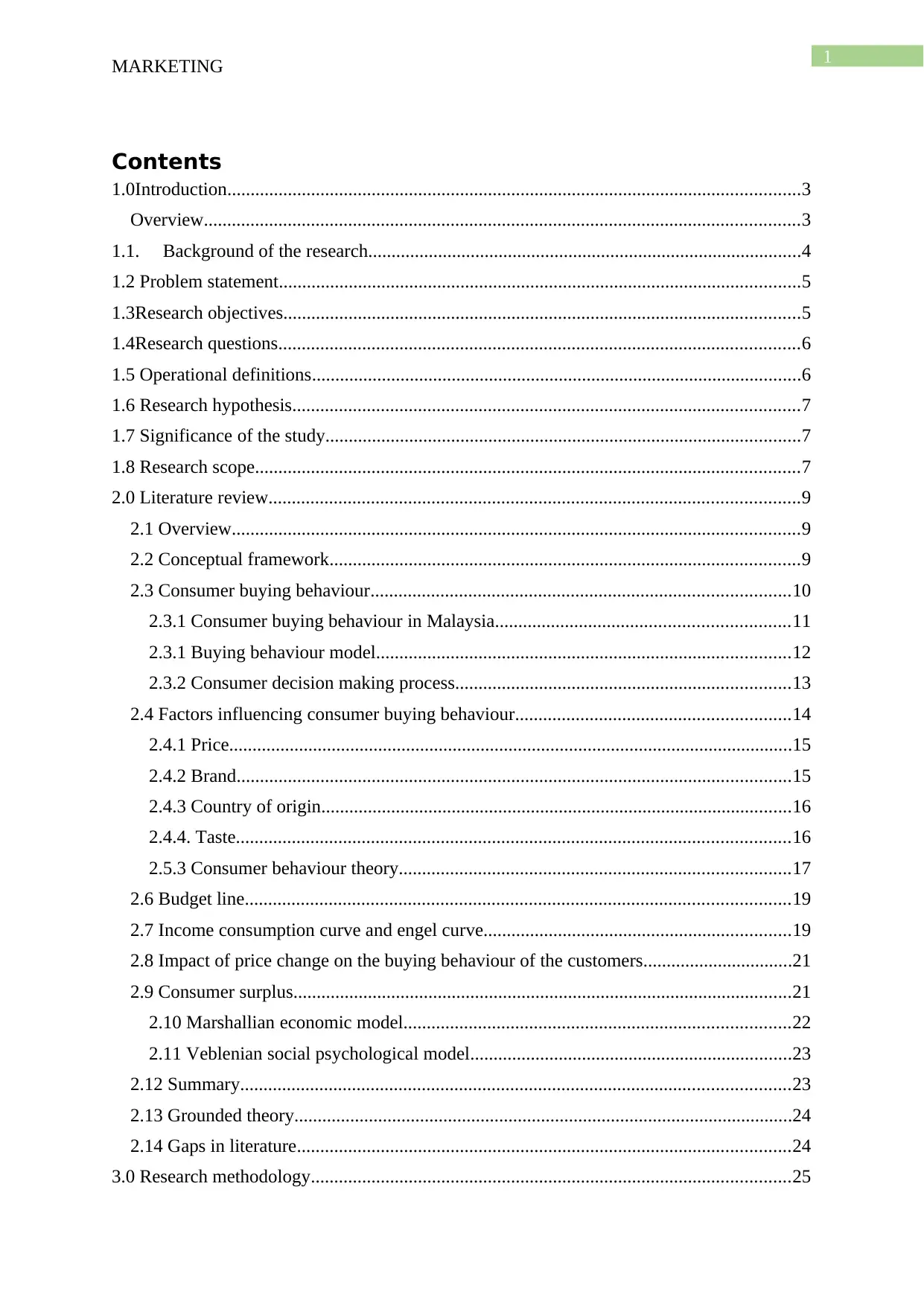
1
MARKETING
Contents
1.0Introduction...........................................................................................................................3
Overview................................................................................................................................3
1.1. Background of the research.............................................................................................4
1.2 Problem statement................................................................................................................5
1.3Research objectives...............................................................................................................5
1.4Research questions................................................................................................................6
1.5 Operational definitions.........................................................................................................6
1.6 Research hypothesis.............................................................................................................7
1.7 Significance of the study......................................................................................................7
1.8 Research scope.....................................................................................................................7
2.0 Literature review..................................................................................................................9
2.1 Overview..........................................................................................................................9
2.2 Conceptual framework.....................................................................................................9
2.3 Consumer buying behaviour..........................................................................................10
2.3.1 Consumer buying behaviour in Malaysia...............................................................11
2.3.1 Buying behaviour model.........................................................................................12
2.3.2 Consumer decision making process........................................................................13
2.4 Factors influencing consumer buying behaviour...........................................................14
2.4.1 Price.........................................................................................................................15
2.4.2 Brand.......................................................................................................................15
2.4.3 Country of origin.....................................................................................................16
2.4.4. Taste.......................................................................................................................16
2.5.3 Consumer behaviour theory....................................................................................17
2.6 Budget line.....................................................................................................................19
2.7 Income consumption curve and engel curve..................................................................19
2.8 Impact of price change on the buying behaviour of the customers................................21
2.9 Consumer surplus...........................................................................................................21
2.10 Marshallian economic model...................................................................................22
2.11 Veblenian social psychological model.....................................................................23
2.12 Summary......................................................................................................................23
2.13 Grounded theory...........................................................................................................24
2.14 Gaps in literature..........................................................................................................24
3.0 Research methodology.......................................................................................................25
MARKETING
Contents
1.0Introduction...........................................................................................................................3
Overview................................................................................................................................3
1.1. Background of the research.............................................................................................4
1.2 Problem statement................................................................................................................5
1.3Research objectives...............................................................................................................5
1.4Research questions................................................................................................................6
1.5 Operational definitions.........................................................................................................6
1.6 Research hypothesis.............................................................................................................7
1.7 Significance of the study......................................................................................................7
1.8 Research scope.....................................................................................................................7
2.0 Literature review..................................................................................................................9
2.1 Overview..........................................................................................................................9
2.2 Conceptual framework.....................................................................................................9
2.3 Consumer buying behaviour..........................................................................................10
2.3.1 Consumer buying behaviour in Malaysia...............................................................11
2.3.1 Buying behaviour model.........................................................................................12
2.3.2 Consumer decision making process........................................................................13
2.4 Factors influencing consumer buying behaviour...........................................................14
2.4.1 Price.........................................................................................................................15
2.4.2 Brand.......................................................................................................................15
2.4.3 Country of origin.....................................................................................................16
2.4.4. Taste.......................................................................................................................16
2.5.3 Consumer behaviour theory....................................................................................17
2.6 Budget line.....................................................................................................................19
2.7 Income consumption curve and engel curve..................................................................19
2.8 Impact of price change on the buying behaviour of the customers................................21
2.9 Consumer surplus...........................................................................................................21
2.10 Marshallian economic model...................................................................................22
2.11 Veblenian social psychological model.....................................................................23
2.12 Summary......................................................................................................................23
2.13 Grounded theory...........................................................................................................24
2.14 Gaps in literature..........................................................................................................24
3.0 Research methodology.......................................................................................................25
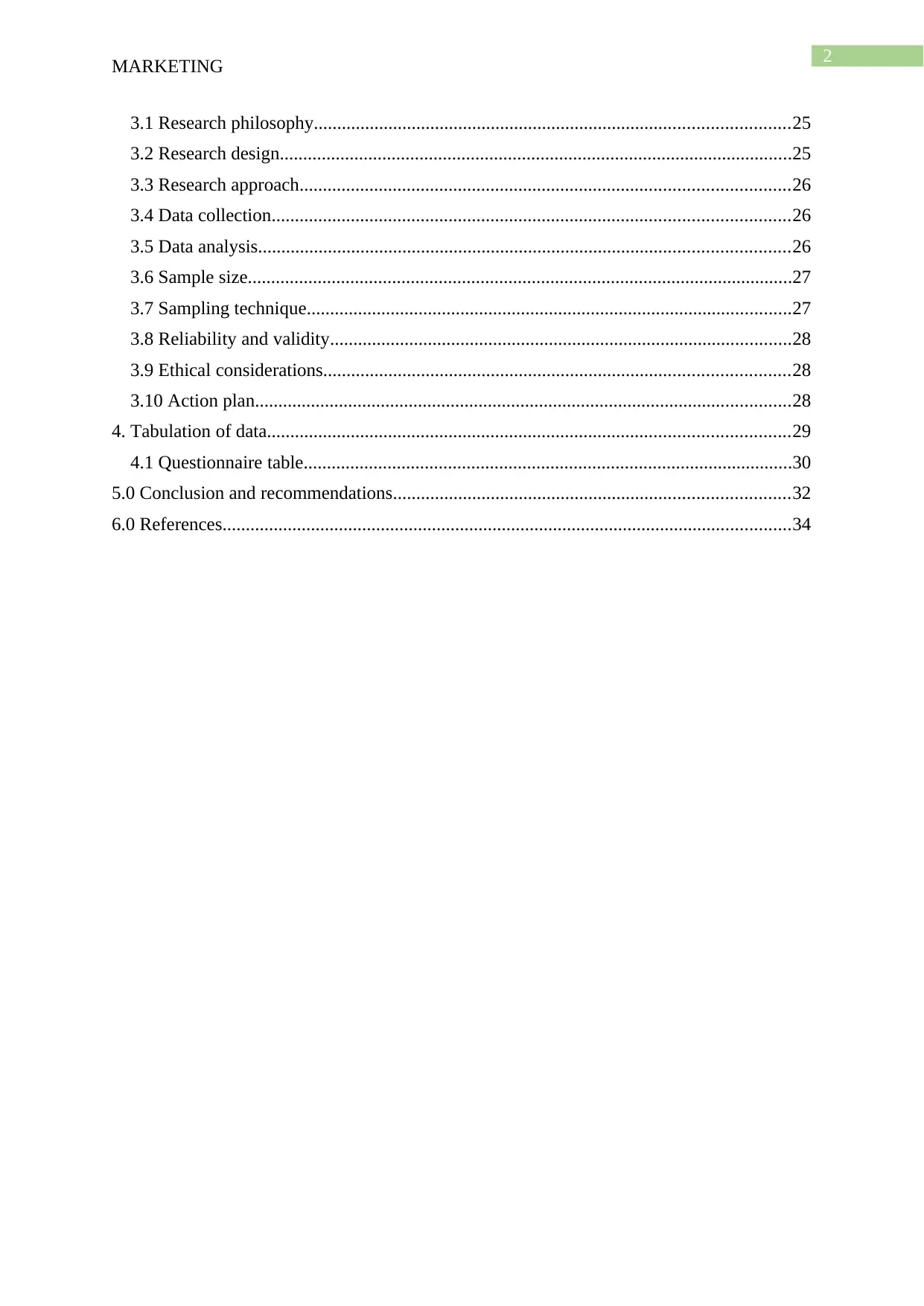
2
MARKETING
3.1 Research philosophy......................................................................................................25
3.2 Research design..............................................................................................................25
3.3 Research approach.........................................................................................................26
3.4 Data collection...............................................................................................................26
3.5 Data analysis..................................................................................................................26
3.6 Sample size.....................................................................................................................27
3.7 Sampling technique........................................................................................................27
3.8 Reliability and validity...................................................................................................28
3.9 Ethical considerations....................................................................................................28
3.10 Action plan...................................................................................................................28
4. Tabulation of data................................................................................................................29
4.1 Questionnaire table.........................................................................................................30
5.0 Conclusion and recommendations.....................................................................................32
6.0 References..........................................................................................................................34
MARKETING
3.1 Research philosophy......................................................................................................25
3.2 Research design..............................................................................................................25
3.3 Research approach.........................................................................................................26
3.4 Data collection...............................................................................................................26
3.5 Data analysis..................................................................................................................26
3.6 Sample size.....................................................................................................................27
3.7 Sampling technique........................................................................................................27
3.8 Reliability and validity...................................................................................................28
3.9 Ethical considerations....................................................................................................28
3.10 Action plan...................................................................................................................28
4. Tabulation of data................................................................................................................29
4.1 Questionnaire table.........................................................................................................30
5.0 Conclusion and recommendations.....................................................................................32
6.0 References..........................................................................................................................34
⊘ This is a preview!⊘
Do you want full access?
Subscribe today to unlock all pages.

Trusted by 1+ million students worldwide
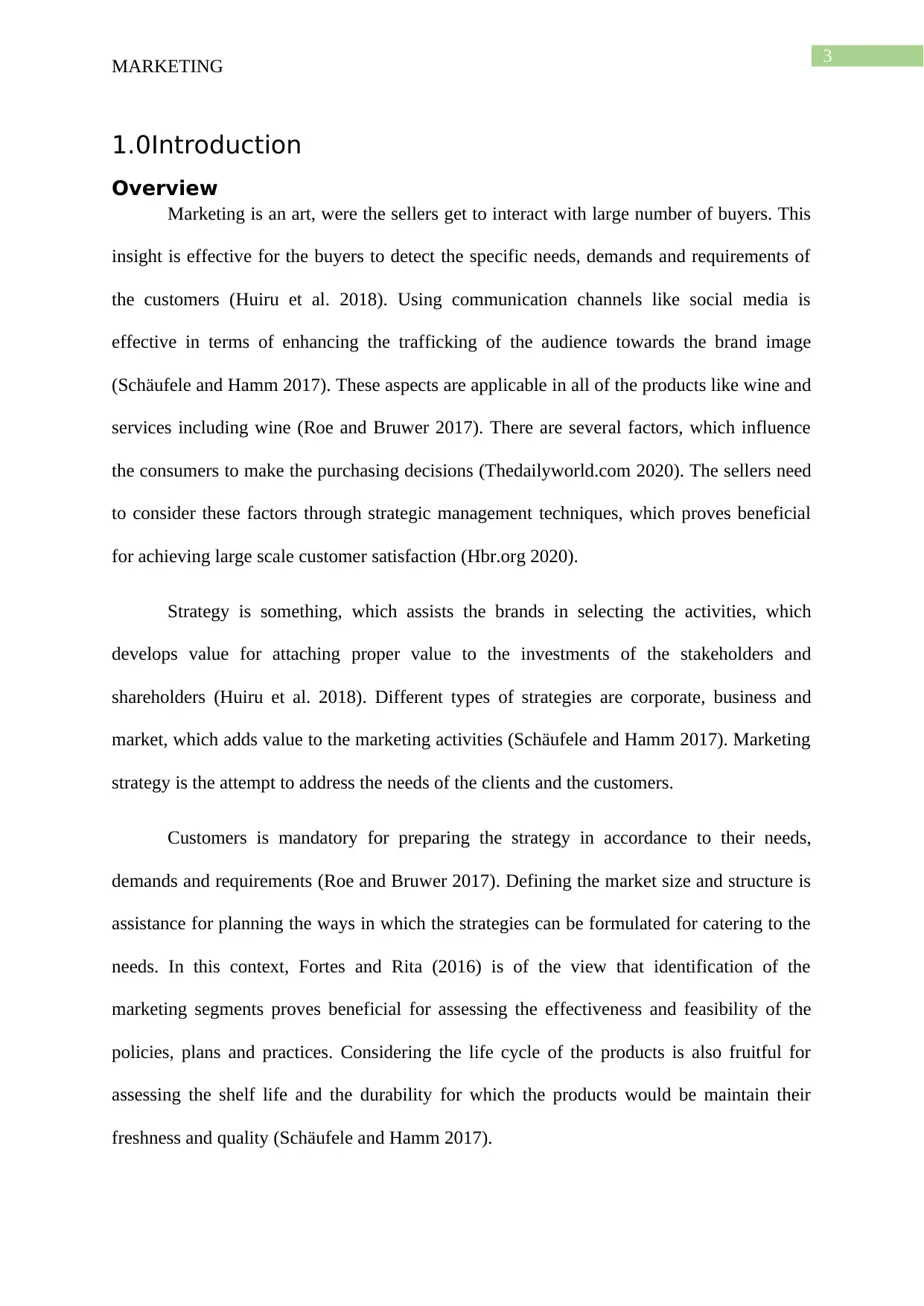
3
MARKETING
1.0Introduction
Overview
Marketing is an art, were the sellers get to interact with large number of buyers. This
insight is effective for the buyers to detect the specific needs, demands and requirements of
the customers (Huiru et al. 2018). Using communication channels like social media is
effective in terms of enhancing the trafficking of the audience towards the brand image
(Schäufele and Hamm 2017). These aspects are applicable in all of the products like wine and
services including wine (Roe and Bruwer 2017). There are several factors, which influence
the consumers to make the purchasing decisions (Thedailyworld.com 2020). The sellers need
to consider these factors through strategic management techniques, which proves beneficial
for achieving large scale customer satisfaction (Hbr.org 2020).
Strategy is something, which assists the brands in selecting the activities, which
develops value for attaching proper value to the investments of the stakeholders and
shareholders (Huiru et al. 2018). Different types of strategies are corporate, business and
market, which adds value to the marketing activities (Schäufele and Hamm 2017). Marketing
strategy is the attempt to address the needs of the clients and the customers.
Customers is mandatory for preparing the strategy in accordance to their needs,
demands and requirements (Roe and Bruwer 2017). Defining the market size and structure is
assistance for planning the ways in which the strategies can be formulated for catering to the
needs. In this context, Fortes and Rita (2016) is of the view that identification of the
marketing segments proves beneficial for assessing the effectiveness and feasibility of the
policies, plans and practices. Considering the life cycle of the products is also fruitful for
assessing the shelf life and the durability for which the products would be maintain their
freshness and quality (Schäufele and Hamm 2017).
MARKETING
1.0Introduction
Overview
Marketing is an art, were the sellers get to interact with large number of buyers. This
insight is effective for the buyers to detect the specific needs, demands and requirements of
the customers (Huiru et al. 2018). Using communication channels like social media is
effective in terms of enhancing the trafficking of the audience towards the brand image
(Schäufele and Hamm 2017). These aspects are applicable in all of the products like wine and
services including wine (Roe and Bruwer 2017). There are several factors, which influence
the consumers to make the purchasing decisions (Thedailyworld.com 2020). The sellers need
to consider these factors through strategic management techniques, which proves beneficial
for achieving large scale customer satisfaction (Hbr.org 2020).
Strategy is something, which assists the brands in selecting the activities, which
develops value for attaching proper value to the investments of the stakeholders and
shareholders (Huiru et al. 2018). Different types of strategies are corporate, business and
market, which adds value to the marketing activities (Schäufele and Hamm 2017). Marketing
strategy is the attempt to address the needs of the clients and the customers.
Customers is mandatory for preparing the strategy in accordance to their needs,
demands and requirements (Roe and Bruwer 2017). Defining the market size and structure is
assistance for planning the ways in which the strategies can be formulated for catering to the
needs. In this context, Fortes and Rita (2016) is of the view that identification of the
marketing segments proves beneficial for assessing the effectiveness and feasibility of the
policies, plans and practices. Considering the life cycle of the products is also fruitful for
assessing the shelf life and the durability for which the products would be maintain their
freshness and quality (Schäufele and Hamm 2017).
Paraphrase This Document
Need a fresh take? Get an instant paraphrase of this document with our AI Paraphraser
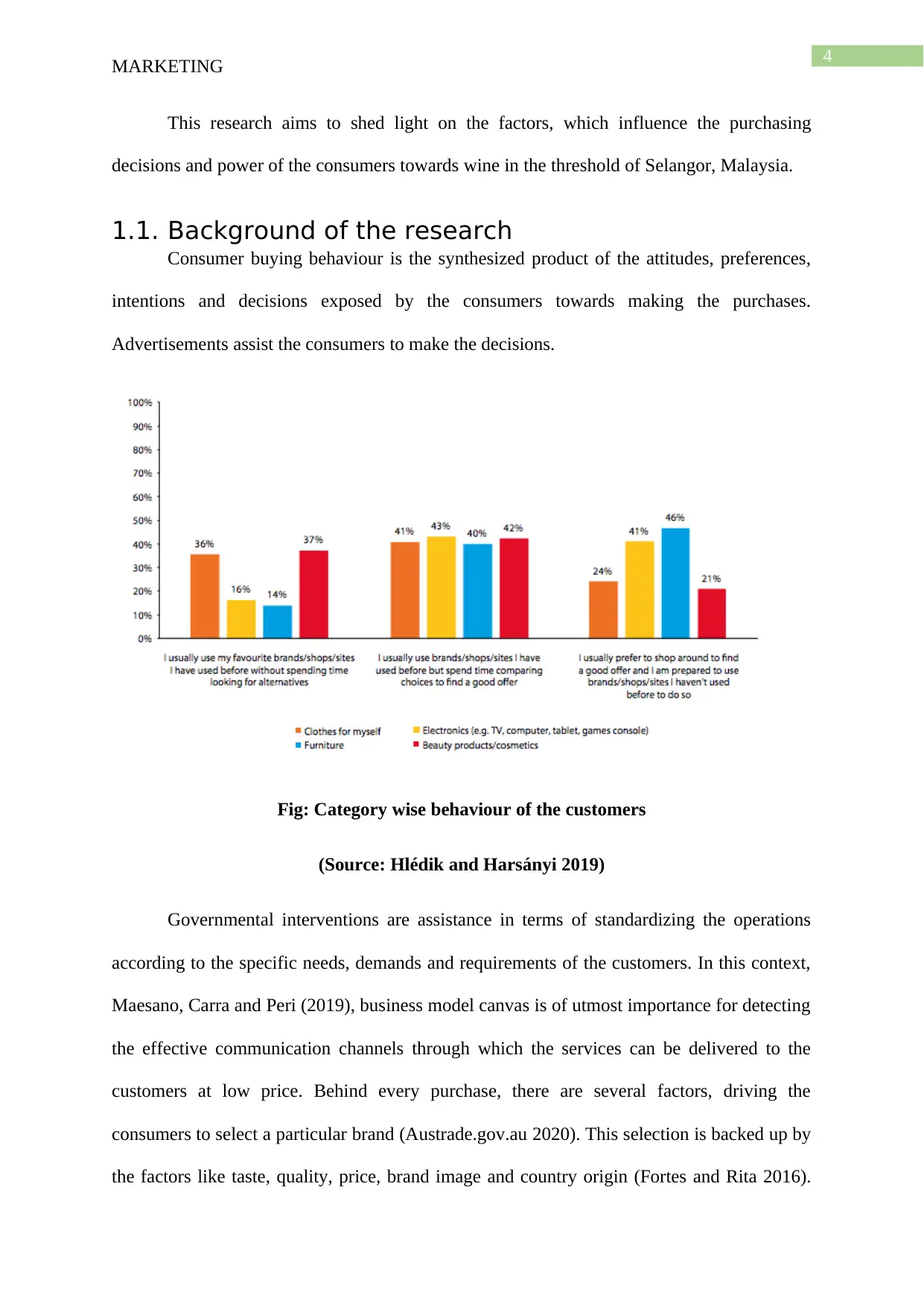
4
MARKETING
This research aims to shed light on the factors, which influence the purchasing
decisions and power of the consumers towards wine in the threshold of Selangor, Malaysia.
1.1. Background of the research
Consumer buying behaviour is the synthesized product of the attitudes, preferences,
intentions and decisions exposed by the consumers towards making the purchases.
Advertisements assist the consumers to make the decisions.
Fig: Category wise behaviour of the customers
(Source: Hlédik and Harsányi 2019)
Governmental interventions are assistance in terms of standardizing the operations
according to the specific needs, demands and requirements of the customers. In this context,
Maesano, Carra and Peri (2019), business model canvas is of utmost importance for detecting
the effective communication channels through which the services can be delivered to the
customers at low price. Behind every purchase, there are several factors, driving the
consumers to select a particular brand (Austrade.gov.au 2020). This selection is backed up by
the factors like taste, quality, price, brand image and country origin (Fortes and Rita 2016).
MARKETING
This research aims to shed light on the factors, which influence the purchasing
decisions and power of the consumers towards wine in the threshold of Selangor, Malaysia.
1.1. Background of the research
Consumer buying behaviour is the synthesized product of the attitudes, preferences,
intentions and decisions exposed by the consumers towards making the purchases.
Advertisements assist the consumers to make the decisions.
Fig: Category wise behaviour of the customers
(Source: Hlédik and Harsányi 2019)
Governmental interventions are assistance in terms of standardizing the operations
according to the specific needs, demands and requirements of the customers. In this context,
Maesano, Carra and Peri (2019), business model canvas is of utmost importance for detecting
the effective communication channels through which the services can be delivered to the
customers at low price. Behind every purchase, there are several factors, driving the
consumers to select a particular brand (Austrade.gov.au 2020). This selection is backed up by
the factors like taste, quality, price, brand image and country origin (Fortes and Rita 2016).
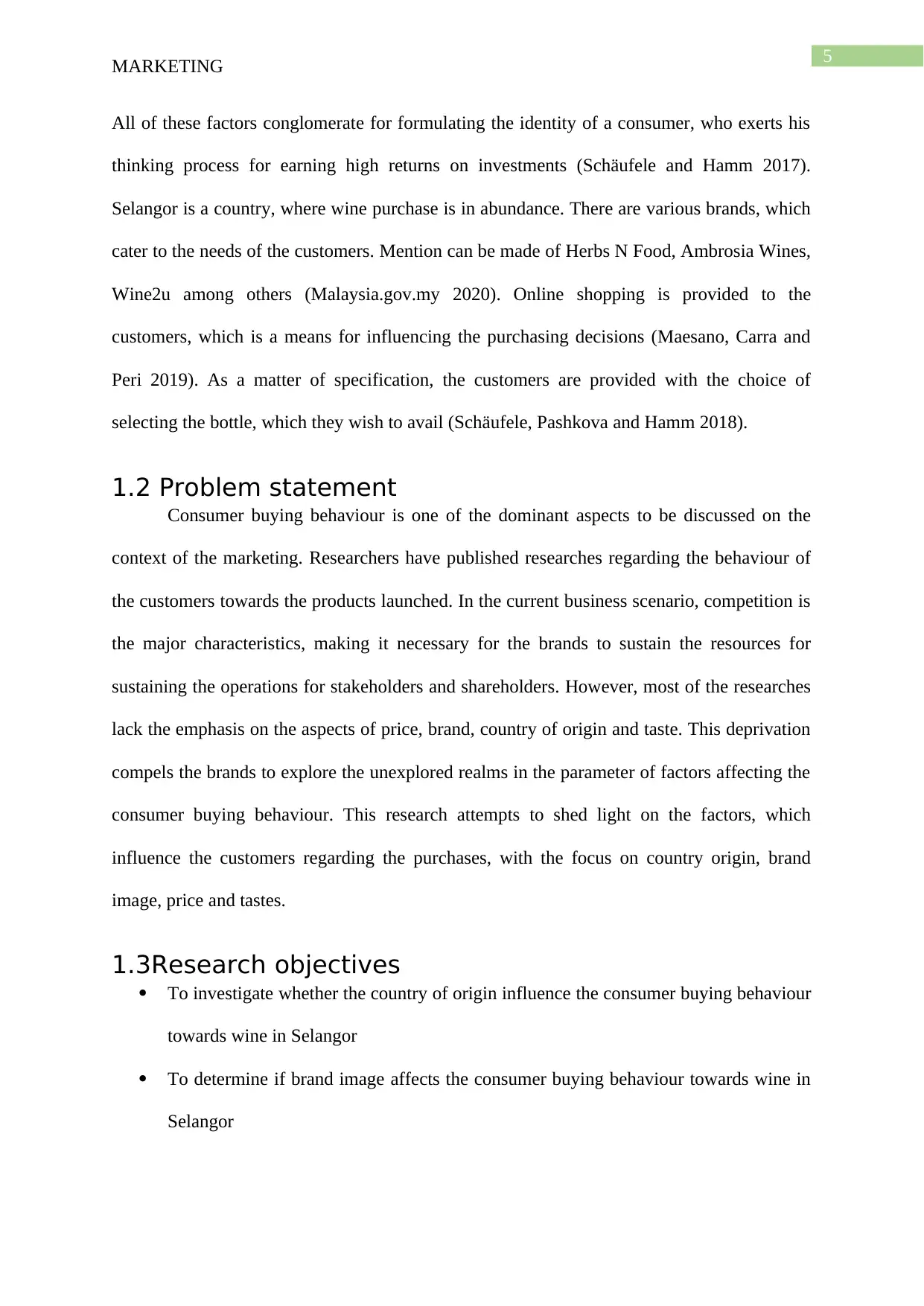
5
MARKETING
All of these factors conglomerate for formulating the identity of a consumer, who exerts his
thinking process for earning high returns on investments (Schäufele and Hamm 2017).
Selangor is a country, where wine purchase is in abundance. There are various brands, which
cater to the needs of the customers. Mention can be made of Herbs N Food, Ambrosia Wines,
Wine2u among others (Malaysia.gov.my 2020). Online shopping is provided to the
customers, which is a means for influencing the purchasing decisions (Maesano, Carra and
Peri 2019). As a matter of specification, the customers are provided with the choice of
selecting the bottle, which they wish to avail (Schäufele, Pashkova and Hamm 2018).
1.2 Problem statement
Consumer buying behaviour is one of the dominant aspects to be discussed on the
context of the marketing. Researchers have published researches regarding the behaviour of
the customers towards the products launched. In the current business scenario, competition is
the major characteristics, making it necessary for the brands to sustain the resources for
sustaining the operations for stakeholders and shareholders. However, most of the researches
lack the emphasis on the aspects of price, brand, country of origin and taste. This deprivation
compels the brands to explore the unexplored realms in the parameter of factors affecting the
consumer buying behaviour. This research attempts to shed light on the factors, which
influence the customers regarding the purchases, with the focus on country origin, brand
image, price and tastes.
1.3Research objectives
To investigate whether the country of origin influence the consumer buying behaviour
towards wine in Selangor
To determine if brand image affects the consumer buying behaviour towards wine in
Selangor
MARKETING
All of these factors conglomerate for formulating the identity of a consumer, who exerts his
thinking process for earning high returns on investments (Schäufele and Hamm 2017).
Selangor is a country, where wine purchase is in abundance. There are various brands, which
cater to the needs of the customers. Mention can be made of Herbs N Food, Ambrosia Wines,
Wine2u among others (Malaysia.gov.my 2020). Online shopping is provided to the
customers, which is a means for influencing the purchasing decisions (Maesano, Carra and
Peri 2019). As a matter of specification, the customers are provided with the choice of
selecting the bottle, which they wish to avail (Schäufele, Pashkova and Hamm 2018).
1.2 Problem statement
Consumer buying behaviour is one of the dominant aspects to be discussed on the
context of the marketing. Researchers have published researches regarding the behaviour of
the customers towards the products launched. In the current business scenario, competition is
the major characteristics, making it necessary for the brands to sustain the resources for
sustaining the operations for stakeholders and shareholders. However, most of the researches
lack the emphasis on the aspects of price, brand, country of origin and taste. This deprivation
compels the brands to explore the unexplored realms in the parameter of factors affecting the
consumer buying behaviour. This research attempts to shed light on the factors, which
influence the customers regarding the purchases, with the focus on country origin, brand
image, price and tastes.
1.3Research objectives
To investigate whether the country of origin influence the consumer buying behaviour
towards wine in Selangor
To determine if brand image affects the consumer buying behaviour towards wine in
Selangor
⊘ This is a preview!⊘
Do you want full access?
Subscribe today to unlock all pages.

Trusted by 1+ million students worldwide
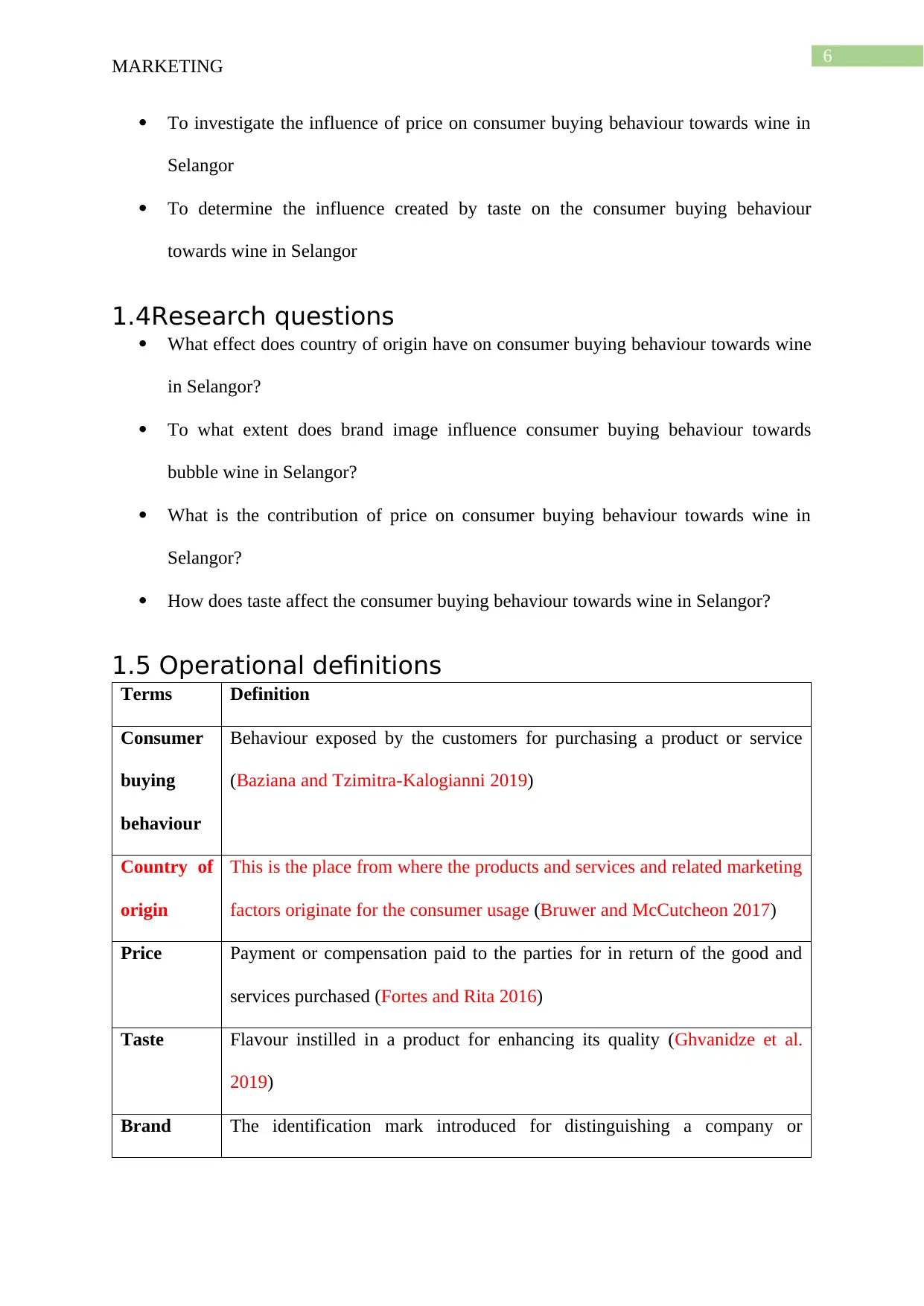
6
MARKETING
To investigate the influence of price on consumer buying behaviour towards wine in
Selangor
To determine the influence created by taste on the consumer buying behaviour
towards wine in Selangor
1.4Research questions
What effect does country of origin have on consumer buying behaviour towards wine
in Selangor?
To what extent does brand image influence consumer buying behaviour towards
bubble wine in Selangor?
What is the contribution of price on consumer buying behaviour towards wine in
Selangor?
How does taste affect the consumer buying behaviour towards wine in Selangor?
1.5 Operational definitions
Terms Definition
Consumer
buying
behaviour
Behaviour exposed by the customers for purchasing a product or service
(Baziana and Tzimitra-Kalogianni 2019)
Country of
origin
This is the place from where the products and services and related marketing
factors originate for the consumer usage (Bruwer and McCutcheon 2017)
Price Payment or compensation paid to the parties for in return of the good and
services purchased (Fortes and Rita 2016)
Taste Flavour instilled in a product for enhancing its quality (Ghvanidze et al.
2019)
Brand The identification mark introduced for distinguishing a company or
MARKETING
To investigate the influence of price on consumer buying behaviour towards wine in
Selangor
To determine the influence created by taste on the consumer buying behaviour
towards wine in Selangor
1.4Research questions
What effect does country of origin have on consumer buying behaviour towards wine
in Selangor?
To what extent does brand image influence consumer buying behaviour towards
bubble wine in Selangor?
What is the contribution of price on consumer buying behaviour towards wine in
Selangor?
How does taste affect the consumer buying behaviour towards wine in Selangor?
1.5 Operational definitions
Terms Definition
Consumer
buying
behaviour
Behaviour exposed by the customers for purchasing a product or service
(Baziana and Tzimitra-Kalogianni 2019)
Country of
origin
This is the place from where the products and services and related marketing
factors originate for the consumer usage (Bruwer and McCutcheon 2017)
Price Payment or compensation paid to the parties for in return of the good and
services purchased (Fortes and Rita 2016)
Taste Flavour instilled in a product for enhancing its quality (Ghvanidze et al.
2019)
Brand The identification mark introduced for distinguishing a company or
Paraphrase This Document
Need a fresh take? Get an instant paraphrase of this document with our AI Paraphraser
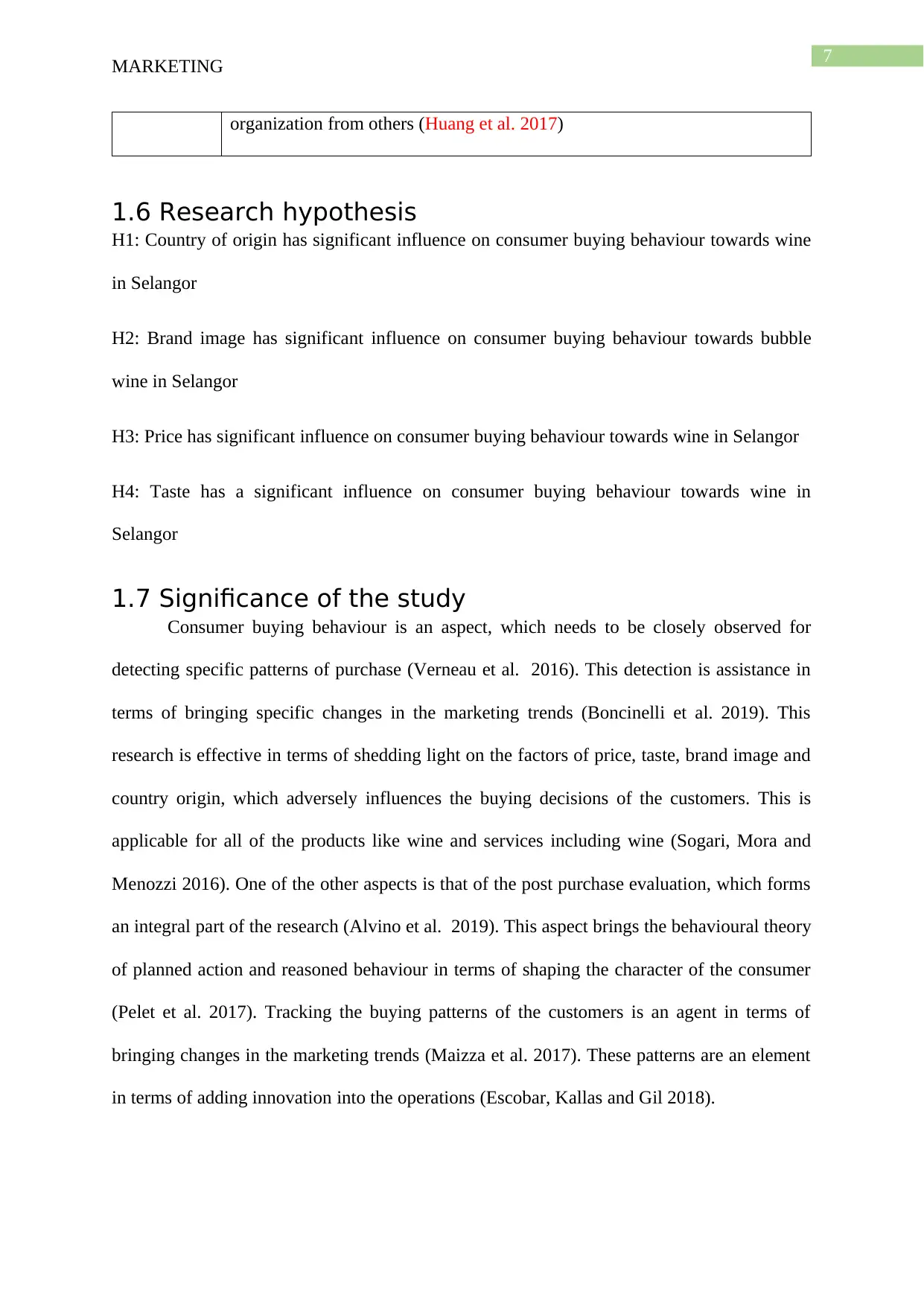
7
MARKETING
organization from others (Huang et al. 2017)
1.6 Research hypothesis
H1: Country of origin has significant influence on consumer buying behaviour towards wine
in Selangor
H2: Brand image has significant influence on consumer buying behaviour towards bubble
wine in Selangor
H3: Price has significant influence on consumer buying behaviour towards wine in Selangor
H4: Taste has a significant influence on consumer buying behaviour towards wine in
Selangor
1.7 Significance of the study
Consumer buying behaviour is an aspect, which needs to be closely observed for
detecting specific patterns of purchase (Verneau et al. 2016). This detection is assistance in
terms of bringing specific changes in the marketing trends (Boncinelli et al. 2019). This
research is effective in terms of shedding light on the factors of price, taste, brand image and
country origin, which adversely influences the buying decisions of the customers. This is
applicable for all of the products like wine and services including wine (Sogari, Mora and
Menozzi 2016). One of the other aspects is that of the post purchase evaluation, which forms
an integral part of the research (Alvino et al. 2019). This aspect brings the behavioural theory
of planned action and reasoned behaviour in terms of shaping the character of the consumer
(Pelet et al. 2017). Tracking the buying patterns of the customers is an agent in terms of
bringing changes in the marketing trends (Maizza et al. 2017). These patterns are an element
in terms of adding innovation into the operations (Escobar, Kallas and Gil 2018).
MARKETING
organization from others (Huang et al. 2017)
1.6 Research hypothesis
H1: Country of origin has significant influence on consumer buying behaviour towards wine
in Selangor
H2: Brand image has significant influence on consumer buying behaviour towards bubble
wine in Selangor
H3: Price has significant influence on consumer buying behaviour towards wine in Selangor
H4: Taste has a significant influence on consumer buying behaviour towards wine in
Selangor
1.7 Significance of the study
Consumer buying behaviour is an aspect, which needs to be closely observed for
detecting specific patterns of purchase (Verneau et al. 2016). This detection is assistance in
terms of bringing specific changes in the marketing trends (Boncinelli et al. 2019). This
research is effective in terms of shedding light on the factors of price, taste, brand image and
country origin, which adversely influences the buying decisions of the customers. This is
applicable for all of the products like wine and services including wine (Sogari, Mora and
Menozzi 2016). One of the other aspects is that of the post purchase evaluation, which forms
an integral part of the research (Alvino et al. 2019). This aspect brings the behavioural theory
of planned action and reasoned behaviour in terms of shaping the character of the consumer
(Pelet et al. 2017). Tracking the buying patterns of the customers is an agent in terms of
bringing changes in the marketing trends (Maizza et al. 2017). These patterns are an element
in terms of adding innovation into the operations (Escobar, Kallas and Gil 2018).
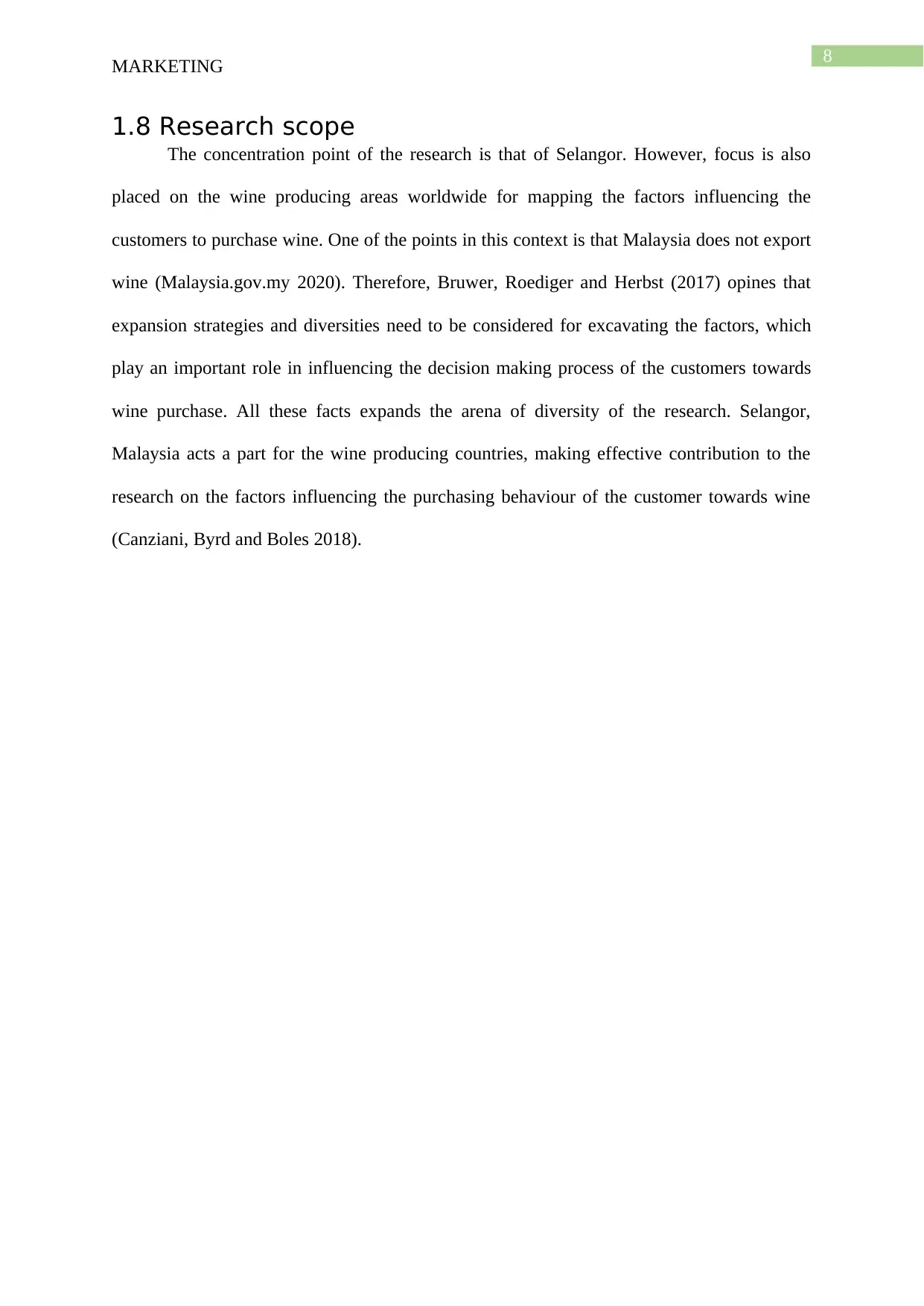
8
MARKETING
1.8 Research scope
The concentration point of the research is that of Selangor. However, focus is also
placed on the wine producing areas worldwide for mapping the factors influencing the
customers to purchase wine. One of the points in this context is that Malaysia does not export
wine (Malaysia.gov.my 2020). Therefore, Bruwer, Roediger and Herbst (2017) opines that
expansion strategies and diversities need to be considered for excavating the factors, which
play an important role in influencing the decision making process of the customers towards
wine purchase. All these facts expands the arena of diversity of the research. Selangor,
Malaysia acts a part for the wine producing countries, making effective contribution to the
research on the factors influencing the purchasing behaviour of the customer towards wine
(Canziani, Byrd and Boles 2018).
MARKETING
1.8 Research scope
The concentration point of the research is that of Selangor. However, focus is also
placed on the wine producing areas worldwide for mapping the factors influencing the
customers to purchase wine. One of the points in this context is that Malaysia does not export
wine (Malaysia.gov.my 2020). Therefore, Bruwer, Roediger and Herbst (2017) opines that
expansion strategies and diversities need to be considered for excavating the factors, which
play an important role in influencing the decision making process of the customers towards
wine purchase. All these facts expands the arena of diversity of the research. Selangor,
Malaysia acts a part for the wine producing countries, making effective contribution to the
research on the factors influencing the purchasing behaviour of the customer towards wine
(Canziani, Byrd and Boles 2018).
⊘ This is a preview!⊘
Do you want full access?
Subscribe today to unlock all pages.

Trusted by 1+ million students worldwide
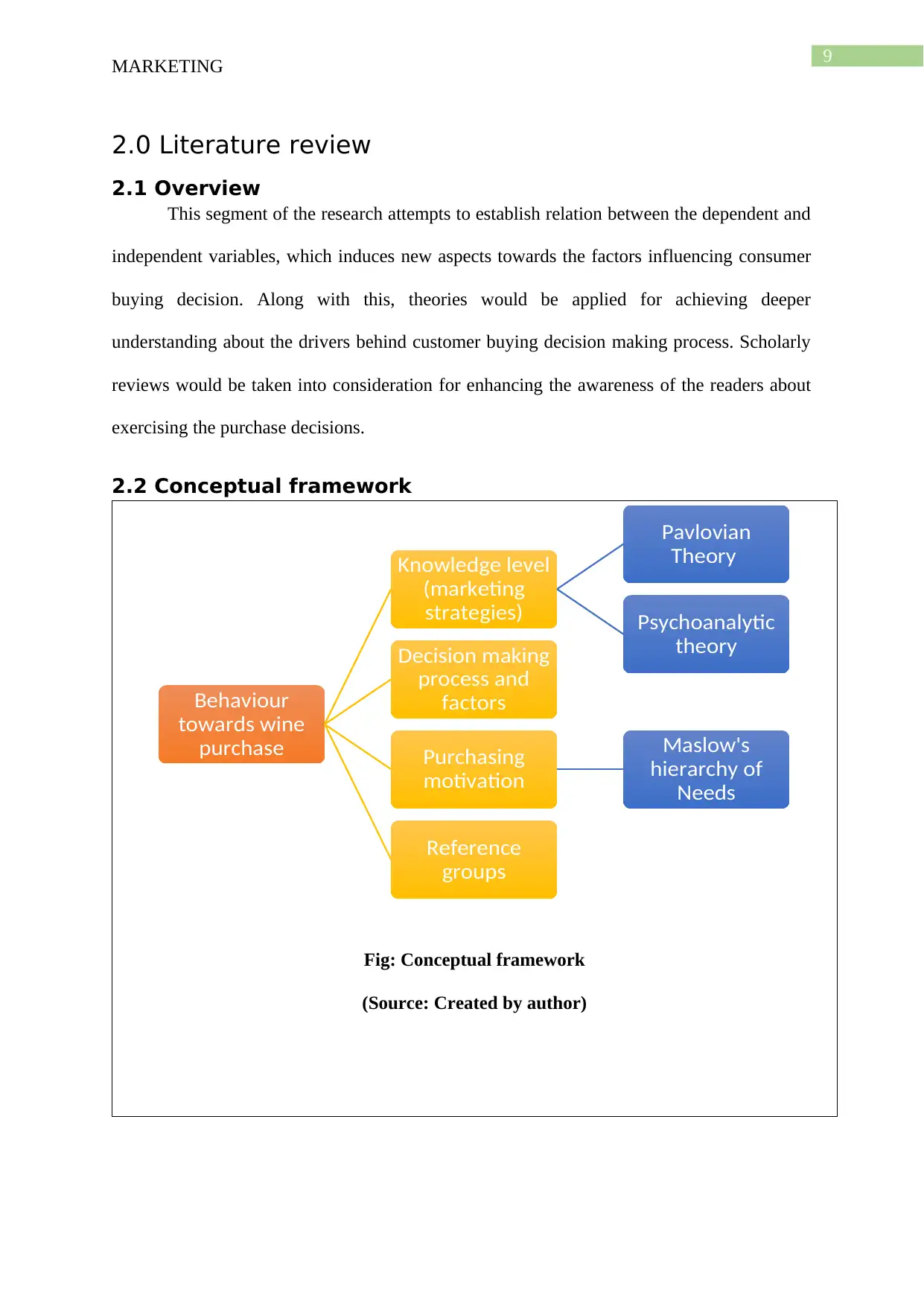
9
MARKETING
2.0 Literature review
2.1 Overview
This segment of the research attempts to establish relation between the dependent and
independent variables, which induces new aspects towards the factors influencing consumer
buying decision. Along with this, theories would be applied for achieving deeper
understanding about the drivers behind customer buying decision making process. Scholarly
reviews would be taken into consideration for enhancing the awareness of the readers about
exercising the purchase decisions.
2.2 Conceptual framework
Fig: Conceptual framework
(Source: Created by author)
Behaviour
towards wine
purchase
Knowledge level
(marketing
strategies)
Pavlovian
Theory
Psychoanalytic
theoryDecision making
process and
factors
Purchasing
motivation
Maslow's
hierarchy of
Needs
Reference
groups
MARKETING
2.0 Literature review
2.1 Overview
This segment of the research attempts to establish relation between the dependent and
independent variables, which induces new aspects towards the factors influencing consumer
buying decision. Along with this, theories would be applied for achieving deeper
understanding about the drivers behind customer buying decision making process. Scholarly
reviews would be taken into consideration for enhancing the awareness of the readers about
exercising the purchase decisions.
2.2 Conceptual framework
Fig: Conceptual framework
(Source: Created by author)
Behaviour
towards wine
purchase
Knowledge level
(marketing
strategies)
Pavlovian
Theory
Psychoanalytic
theoryDecision making
process and
factors
Purchasing
motivation
Maslow's
hierarchy of
Needs
Reference
groups
Paraphrase This Document
Need a fresh take? Get an instant paraphrase of this document with our AI Paraphraser
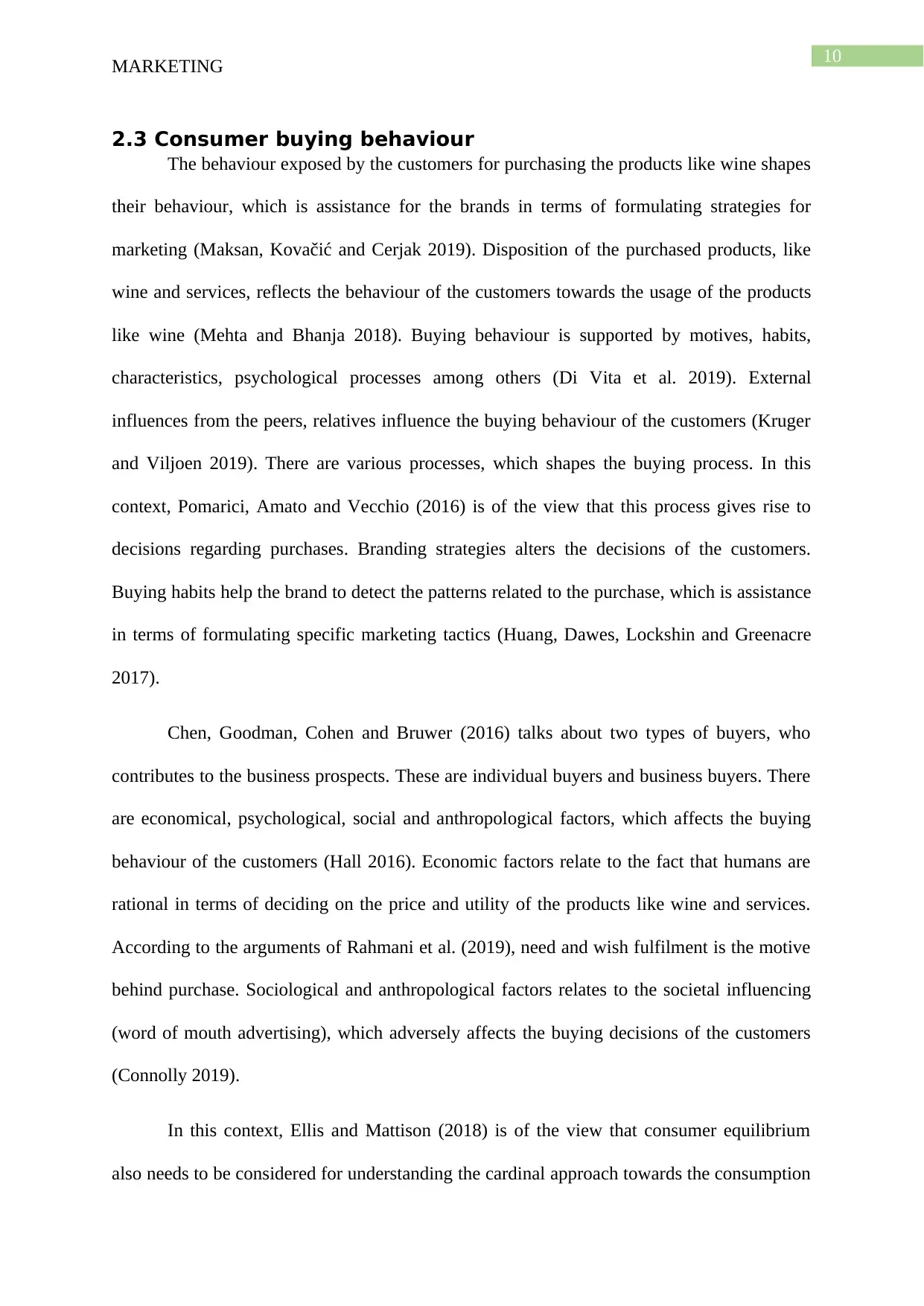
10
MARKETING
2.3 Consumer buying behaviour
The behaviour exposed by the customers for purchasing the products like wine shapes
their behaviour, which is assistance for the brands in terms of formulating strategies for
marketing (Maksan, Kovačić and Cerjak 2019). Disposition of the purchased products, like
wine and services, reflects the behaviour of the customers towards the usage of the products
like wine (Mehta and Bhanja 2018). Buying behaviour is supported by motives, habits,
characteristics, psychological processes among others (Di Vita et al. 2019). External
influences from the peers, relatives influence the buying behaviour of the customers (Kruger
and Viljoen 2019). There are various processes, which shapes the buying process. In this
context, Pomarici, Amato and Vecchio (2016) is of the view that this process gives rise to
decisions regarding purchases. Branding strategies alters the decisions of the customers.
Buying habits help the brand to detect the patterns related to the purchase, which is assistance
in terms of formulating specific marketing tactics (Huang, Dawes, Lockshin and Greenacre
2017).
Chen, Goodman, Cohen and Bruwer (2016) talks about two types of buyers, who
contributes to the business prospects. These are individual buyers and business buyers. There
are economical, psychological, social and anthropological factors, which affects the buying
behaviour of the customers (Hall 2016). Economic factors relate to the fact that humans are
rational in terms of deciding on the price and utility of the products like wine and services.
According to the arguments of Rahmani et al. (2019), need and wish fulfilment is the motive
behind purchase. Sociological and anthropological factors relates to the societal influencing
(word of mouth advertising), which adversely affects the buying decisions of the customers
(Connolly 2019).
In this context, Ellis and Mattison (2018) is of the view that consumer equilibrium
also needs to be considered for understanding the cardinal approach towards the consumption
MARKETING
2.3 Consumer buying behaviour
The behaviour exposed by the customers for purchasing the products like wine shapes
their behaviour, which is assistance for the brands in terms of formulating strategies for
marketing (Maksan, Kovačić and Cerjak 2019). Disposition of the purchased products, like
wine and services, reflects the behaviour of the customers towards the usage of the products
like wine (Mehta and Bhanja 2018). Buying behaviour is supported by motives, habits,
characteristics, psychological processes among others (Di Vita et al. 2019). External
influences from the peers, relatives influence the buying behaviour of the customers (Kruger
and Viljoen 2019). There are various processes, which shapes the buying process. In this
context, Pomarici, Amato and Vecchio (2016) is of the view that this process gives rise to
decisions regarding purchases. Branding strategies alters the decisions of the customers.
Buying habits help the brand to detect the patterns related to the purchase, which is assistance
in terms of formulating specific marketing tactics (Huang, Dawes, Lockshin and Greenacre
2017).
Chen, Goodman, Cohen and Bruwer (2016) talks about two types of buyers, who
contributes to the business prospects. These are individual buyers and business buyers. There
are economical, psychological, social and anthropological factors, which affects the buying
behaviour of the customers (Hall 2016). Economic factors relate to the fact that humans are
rational in terms of deciding on the price and utility of the products like wine and services.
According to the arguments of Rahmani et al. (2019), need and wish fulfilment is the motive
behind purchase. Sociological and anthropological factors relates to the societal influencing
(word of mouth advertising), which adversely affects the buying decisions of the customers
(Connolly 2019).
In this context, Ellis and Mattison (2018) is of the view that consumer equilibrium
also needs to be considered for understanding the cardinal approach towards the consumption
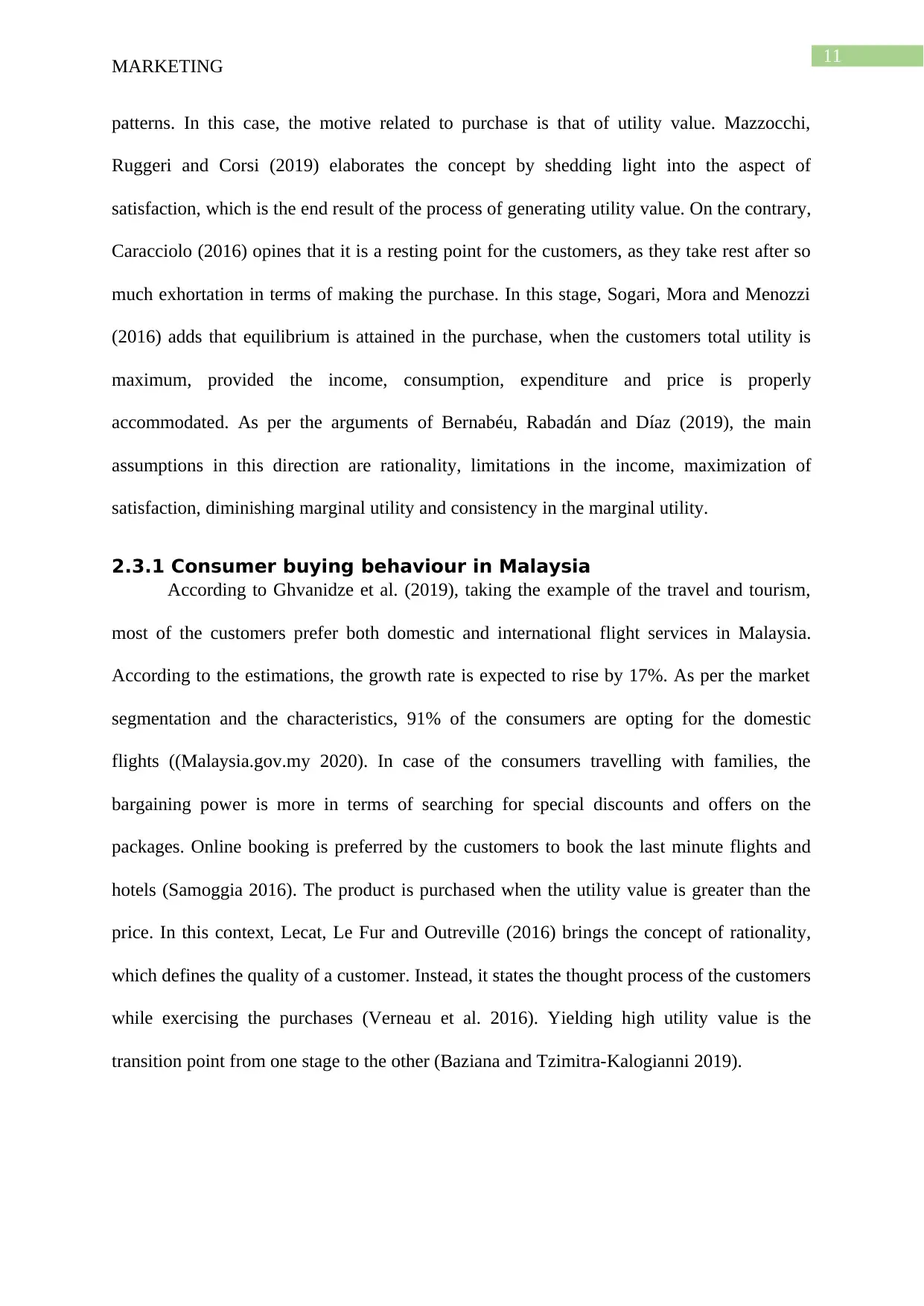
11
MARKETING
patterns. In this case, the motive related to purchase is that of utility value. Mazzocchi,
Ruggeri and Corsi (2019) elaborates the concept by shedding light into the aspect of
satisfaction, which is the end result of the process of generating utility value. On the contrary,
Caracciolo (2016) opines that it is a resting point for the customers, as they take rest after so
much exhortation in terms of making the purchase. In this stage, Sogari, Mora and Menozzi
(2016) adds that equilibrium is attained in the purchase, when the customers total utility is
maximum, provided the income, consumption, expenditure and price is properly
accommodated. As per the arguments of Bernabéu, Rabadán and Díaz (2019), the main
assumptions in this direction are rationality, limitations in the income, maximization of
satisfaction, diminishing marginal utility and consistency in the marginal utility.
2.3.1 Consumer buying behaviour in Malaysia
According to Ghvanidze et al. (2019), taking the example of the travel and tourism,
most of the customers prefer both domestic and international flight services in Malaysia.
According to the estimations, the growth rate is expected to rise by 17%. As per the market
segmentation and the characteristics, 91% of the consumers are opting for the domestic
flights ((Malaysia.gov.my 2020). In case of the consumers travelling with families, the
bargaining power is more in terms of searching for special discounts and offers on the
packages. Online booking is preferred by the customers to book the last minute flights and
hotels (Samoggia 2016). The product is purchased when the utility value is greater than the
price. In this context, Lecat, Le Fur and Outreville (2016) brings the concept of rationality,
which defines the quality of a customer. Instead, it states the thought process of the customers
while exercising the purchases (Verneau et al. 2016). Yielding high utility value is the
transition point from one stage to the other (Baziana and Tzimitra-Kalogianni 2019).
MARKETING
patterns. In this case, the motive related to purchase is that of utility value. Mazzocchi,
Ruggeri and Corsi (2019) elaborates the concept by shedding light into the aspect of
satisfaction, which is the end result of the process of generating utility value. On the contrary,
Caracciolo (2016) opines that it is a resting point for the customers, as they take rest after so
much exhortation in terms of making the purchase. In this stage, Sogari, Mora and Menozzi
(2016) adds that equilibrium is attained in the purchase, when the customers total utility is
maximum, provided the income, consumption, expenditure and price is properly
accommodated. As per the arguments of Bernabéu, Rabadán and Díaz (2019), the main
assumptions in this direction are rationality, limitations in the income, maximization of
satisfaction, diminishing marginal utility and consistency in the marginal utility.
2.3.1 Consumer buying behaviour in Malaysia
According to Ghvanidze et al. (2019), taking the example of the travel and tourism,
most of the customers prefer both domestic and international flight services in Malaysia.
According to the estimations, the growth rate is expected to rise by 17%. As per the market
segmentation and the characteristics, 91% of the consumers are opting for the domestic
flights ((Malaysia.gov.my 2020). In case of the consumers travelling with families, the
bargaining power is more in terms of searching for special discounts and offers on the
packages. Online booking is preferred by the customers to book the last minute flights and
hotels (Samoggia 2016). The product is purchased when the utility value is greater than the
price. In this context, Lecat, Le Fur and Outreville (2016) brings the concept of rationality,
which defines the quality of a customer. Instead, it states the thought process of the customers
while exercising the purchases (Verneau et al. 2016). Yielding high utility value is the
transition point from one stage to the other (Baziana and Tzimitra-Kalogianni 2019).
⊘ This is a preview!⊘
Do you want full access?
Subscribe today to unlock all pages.

Trusted by 1+ million students worldwide
1 out of 41
Related Documents
Your All-in-One AI-Powered Toolkit for Academic Success.
+13062052269
info@desklib.com
Available 24*7 on WhatsApp / Email
![[object Object]](/_next/static/media/star-bottom.7253800d.svg)
Unlock your academic potential
Copyright © 2020–2025 A2Z Services. All Rights Reserved. Developed and managed by ZUCOL.





